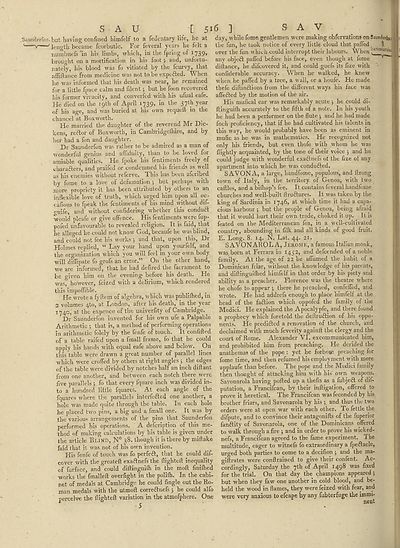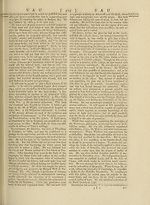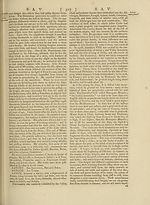Encyclopaedia Britannica, or, a Dictionary of arts, sciences, and miscellaneous literature : enlarged and improved. Illustrated with nearly six hundred engravings > Volume 18, RHI-SCR
(536) Page 516
Download files
Complete book:
Individual page:
Thumbnail gallery: Grid view | List view

S A U [£!
.■Saunderfon. but having confined himfelf to a fedentary life, he at
‘ ■ ' v— ' length became fcorbutic. For feveral years he felt 3
numbnefs in his limbs, which, in the fpring of 1739,
brought on a mortification in his foot "7 and, unfortu¬
nately, his blood was fo vitiated by the fcurvy, that
affiftance from medicine was not to be expefted. When
he was informed that his death was near, he remained
for a little fpace calm and filent •, but he foon recovered
his former vivacity, and converfed with his ufual eafe.
He died on the 19th of April 1739, in the 57th year
of his age, and was buried at his own requeil in the
chancel at Box worth.
He married the daughter of the reverend Mr Dic¬
kens, reflor of Boxworth, in Cambridgefhire, and by
her had a fon and daughter.
Dr Saunderfon was rather to be admired as a man of
wonderful genius and affiduity, than to be loved for
amiable qualities. He fpoke his fentiments freely of
characters, and praifed or condemned his friends as well
as his enemies without referve. Xhis has been afcribed
by fome to a love of defamation ; but perhaps with
more propriety it has been attributed by others to an
inflexible love of truth, which urged him upon all oc-
cafions to fpeak the fentiments of his mind without dif-
guife, and without confidering whether this conduCt
would pleafe or give offence. His fentiments were fup-
pofed unfavourable to revealed religion. It is faid, that
he alleged he could not know God, becaufe he was blind,
and could not fee his works ; and that, upon this, Dr
Holmes replied, “ Lay your hand upon yourfelf, and
the organization which you will feel in your own body
will diffipate fo grofs an error.” On the other hand,
we are informed, that he had defired the facrament to
be given him on the evening- before his death. He
was, however, feized with a delirium, which rendered
this impoflible.
He wrote a fyftem of algebra, which was publilbed, in
2 volumes qto, at London, after his death, in the year
1740, at the expence of the univerfity of Cambridge.
Dr Saunderfon invented for his own ufe a Palpable
Arithmetic •, that is, a method of performing operations
in arithmetic folely by the fenfe of touch. It conlifted
of a table raifed upon a fmall frame, fo that he could
apply his hands with equal eafe above and below. On
this table were drawn a great number of parallel lines
which were croffed by others at right angles 5 the edges
of the table were divided by notches half an inch diftant
from one another, and between each notch there were
five parallels ; fo that every fquare inch was divided in¬
to a hundred little fquares. At each angle of the
fquares where the parallels interfered one another, a
bole was made quite through the table. In each hole
be placed two pins, a big and a fmall one. It was by
the various arrangements of the pins that Saunderfon
performed his operations. A defeription of this me¬
thod of making calculations by his table is given under
the article Blind, N° 38. though it is there by miftake
faid that it was not of his own invention.
His fenfe of touch was fo perfeft, that he could dif-
cover with the greateft exaftnefs the flighteft inequality
of furface, and could diftinguilh in the moft finilhed
works the fmalleft overfight in the polilb. In the cabi¬
net of medals at Cambridge he could fingle out the Ro¬
man medals with the utmoft correftnefs ; he could alfo
perceive the flighteft variation in the atmofphere. One
5
6 ] S A V
day, while fome gentlemen were making observations on Saunderfo
the fun, he took notice of every little cloud that paffed !1
over the fun which could interrupt their labours. When ‘;~dVOnjm>h
any object paffed before his face, even though at fome
diftance, he difeovered it, and could guefs its fize with
confiderable accuracy. When he walked, he knew
when he paffed by a tree, a wall, or a houfe. He made
thefe diftindlions from the different ways his face was
affefled by the motion of the air.
His mufieal ear was remarkably acute ) he could di¬
ftinguilh accurately to the fifth of a note. In his youth
he had been a performer on the flute } and he had made
fuch proficiency, that if he had cultivated his talents in
this way, he would probably have been as eminent in
mufic as be was in mathematics. He recognized not
only his friends, but even thofe with whom he was
(lightly acquainted, by the tone of their voice 5 and he
could judge with wonderful exaftnefs of the fize of any
apartment into which he was conduced.
SAVONA, a large, bandfome, populous, and ftrong
town of Italy, in the territory of Genoa, with two
caftles, and a bifliop’s fee. It contains feveral handfome
churches and well-built ftruftures. It ivas taken by the
king of Sardinia in 1746, at which time it had a capa¬
cious harbour ^ but the people of Genoa, being afraid
that it would hurt their own trade, choked it up. It is
feated on the Mediterranean fea, in a well-cultivated
country, abounding in filk and all kinds of good fruit.
E. Long. 8. 14. N. Lat. 44. 21.
SAVONAROLA, Jerome, a famous Italian monk,
was,born at Ferrara in 1452, and defeended of a noble
family. At the age of 22 he aflumed the habit of a
Dominican friar, without the knowledge of his parents,
and diftinguiftied himfelf in that order by his piety and
ability as a preacher. Florence was the theatre where
he chofe to appear •, there he preached, confeffed, and
wrote. He had addrefs enough to place himfelf at the
head of the faction which oppofed the family of the
Medici. He explained the Apocalypfe, and there found
a prophecy which foretold the deflru&ion of his oppo¬
nents. He predidted a renovation of the church, and
declaimed with much feverity againft the clergy and the
court of Rome. Alexander VI. excommunicated him,
and prohibited him from preaching. He derided the
anathemas of the pope : yet he forbore preaching for
fome time, and then refumed his employment with more
applaufe than before. The pope and the Medici family
then thought of attacking him with hL own weapons.
Savonarola having polled up a thefis as a fubjefl of de¬
putation, a Francifcan, by their inftigation, offered to
prove it heretical. The Francifcan was feconded by his
brother friars, and Savonarola by his *, and thus the two
orders were at open war with each other. To fettle the
difpute, and to convince their antagonifts of the fuperior
fanftity of Savonarola, one of the Dominicans offered
to walk through a fire j and in order to prove his wicked-
nefs, a Francifcan agreed to the fame experiment. The
multitude, eager to witnefs fo extraordinary a fpe&acle,
urged both parties to come to a decifion 5 and the ma-
giftrates were conftrained to give their confent. Ac¬
cordingly, Saturday the 7th of April 1498 was fixed
for the trial. On that day the champions appeared ;
but when they faw one another in cold blood, and be¬
held the wood in flames, they were feized with fear, and
were very anxious to efcape by any fubterfuge the immi¬
nent
.■Saunderfon. but having confined himfelf to a fedentary life, he at
‘ ■ ' v— ' length became fcorbutic. For feveral years he felt 3
numbnefs in his limbs, which, in the fpring of 1739,
brought on a mortification in his foot "7 and, unfortu¬
nately, his blood was fo vitiated by the fcurvy, that
affiftance from medicine was not to be expefted. When
he was informed that his death was near, he remained
for a little fpace calm and filent •, but he foon recovered
his former vivacity, and converfed with his ufual eafe.
He died on the 19th of April 1739, in the 57th year
of his age, and was buried at his own requeil in the
chancel at Box worth.
He married the daughter of the reverend Mr Dic¬
kens, reflor of Boxworth, in Cambridgefhire, and by
her had a fon and daughter.
Dr Saunderfon was rather to be admired as a man of
wonderful genius and affiduity, than to be loved for
amiable qualities. He fpoke his fentiments freely of
characters, and praifed or condemned his friends as well
as his enemies without referve. Xhis has been afcribed
by fome to a love of defamation ; but perhaps with
more propriety it has been attributed by others to an
inflexible love of truth, which urged him upon all oc-
cafions to fpeak the fentiments of his mind without dif-
guife, and without confidering whether this conduCt
would pleafe or give offence. His fentiments were fup-
pofed unfavourable to revealed religion. It is faid, that
he alleged he could not know God, becaufe he was blind,
and could not fee his works ; and that, upon this, Dr
Holmes replied, “ Lay your hand upon yourfelf, and
the organization which you will feel in your own body
will diffipate fo grofs an error.” On the other hand,
we are informed, that he had defired the facrament to
be given him on the evening- before his death. He
was, however, feized with a delirium, which rendered
this impoflible.
He wrote a fyftem of algebra, which was publilbed, in
2 volumes qto, at London, after his death, in the year
1740, at the expence of the univerfity of Cambridge.
Dr Saunderfon invented for his own ufe a Palpable
Arithmetic •, that is, a method of performing operations
in arithmetic folely by the fenfe of touch. It conlifted
of a table raifed upon a fmall frame, fo that he could
apply his hands with equal eafe above and below. On
this table were drawn a great number of parallel lines
which were croffed by others at right angles 5 the edges
of the table were divided by notches half an inch diftant
from one another, and between each notch there were
five parallels ; fo that every fquare inch was divided in¬
to a hundred little fquares. At each angle of the
fquares where the parallels interfered one another, a
bole was made quite through the table. In each hole
be placed two pins, a big and a fmall one. It was by
the various arrangements of the pins that Saunderfon
performed his operations. A defeription of this me¬
thod of making calculations by his table is given under
the article Blind, N° 38. though it is there by miftake
faid that it was not of his own invention.
His fenfe of touch was fo perfeft, that he could dif-
cover with the greateft exaftnefs the flighteft inequality
of furface, and could diftinguilh in the moft finilhed
works the fmalleft overfight in the polilb. In the cabi¬
net of medals at Cambridge he could fingle out the Ro¬
man medals with the utmoft correftnefs ; he could alfo
perceive the flighteft variation in the atmofphere. One
5
6 ] S A V
day, while fome gentlemen were making observations on Saunderfo
the fun, he took notice of every little cloud that paffed !1
over the fun which could interrupt their labours. When ‘;~dVOnjm>h
any object paffed before his face, even though at fome
diftance, he difeovered it, and could guefs its fize with
confiderable accuracy. When he walked, he knew
when he paffed by a tree, a wall, or a houfe. He made
thefe diftindlions from the different ways his face was
affefled by the motion of the air.
His mufieal ear was remarkably acute ) he could di¬
ftinguilh accurately to the fifth of a note. In his youth
he had been a performer on the flute } and he had made
fuch proficiency, that if he had cultivated his talents in
this way, he would probably have been as eminent in
mufic as be was in mathematics. He recognized not
only his friends, but even thofe with whom he was
(lightly acquainted, by the tone of their voice 5 and he
could judge with wonderful exaftnefs of the fize of any
apartment into which he was conduced.
SAVONA, a large, bandfome, populous, and ftrong
town of Italy, in the territory of Genoa, with two
caftles, and a bifliop’s fee. It contains feveral handfome
churches and well-built ftruftures. It ivas taken by the
king of Sardinia in 1746, at which time it had a capa¬
cious harbour ^ but the people of Genoa, being afraid
that it would hurt their own trade, choked it up. It is
feated on the Mediterranean fea, in a well-cultivated
country, abounding in filk and all kinds of good fruit.
E. Long. 8. 14. N. Lat. 44. 21.
SAVONAROLA, Jerome, a famous Italian monk,
was,born at Ferrara in 1452, and defeended of a noble
family. At the age of 22 he aflumed the habit of a
Dominican friar, without the knowledge of his parents,
and diftinguiftied himfelf in that order by his piety and
ability as a preacher. Florence was the theatre where
he chofe to appear •, there he preached, confeffed, and
wrote. He had addrefs enough to place himfelf at the
head of the faction which oppofed the family of the
Medici. He explained the Apocalypfe, and there found
a prophecy which foretold the deflru&ion of his oppo¬
nents. He predidted a renovation of the church, and
declaimed with much feverity againft the clergy and the
court of Rome. Alexander VI. excommunicated him,
and prohibited him from preaching. He derided the
anathemas of the pope : yet he forbore preaching for
fome time, and then refumed his employment with more
applaufe than before. The pope and the Medici family
then thought of attacking him with hL own weapons.
Savonarola having polled up a thefis as a fubjefl of de¬
putation, a Francifcan, by their inftigation, offered to
prove it heretical. The Francifcan was feconded by his
brother friars, and Savonarola by his *, and thus the two
orders were at open war with each other. To fettle the
difpute, and to convince their antagonifts of the fuperior
fanftity of Savonarola, one of the Dominicans offered
to walk through a fire j and in order to prove his wicked-
nefs, a Francifcan agreed to the fame experiment. The
multitude, eager to witnefs fo extraordinary a fpe&acle,
urged both parties to come to a decifion 5 and the ma-
giftrates were conftrained to give their confent. Ac¬
cordingly, Saturday the 7th of April 1498 was fixed
for the trial. On that day the champions appeared ;
but when they faw one another in cold blood, and be¬
held the wood in flames, they were feized with fear, and
were very anxious to efcape by any fubterfuge the immi¬
nent
Set display mode to:
![]() Universal Viewer |
Universal Viewer | ![]() Mirador |
Large image | Transcription
Mirador |
Large image | Transcription
Images and transcriptions on this page, including medium image downloads, may be used under the Creative Commons Attribution 4.0 International Licence unless otherwise stated. ![]()
| Permanent URL | https://digital.nls.uk/193025675 |
|---|
| Attribution and copyright: |
|
|---|
| Description | Ten editions of 'Encyclopaedia Britannica', issued from 1768-1903, in 231 volumes. Originally issued in 100 weekly parts (3 volumes) between 1768 and 1771 by publishers: Colin Macfarquhar and Andrew Bell (Edinburgh); editor: William Smellie: engraver: Andrew Bell. Expanded editions in the 19th century featured more volumes and contributions from leading experts in their fields. Managed and published in Edinburgh up to the 9th edition (25 volumes, from 1875-1889); the 10th edition (1902-1903) re-issued the 9th edition, with 11 supplementary volumes. |
|---|---|
| Additional NLS resources: |
|

